Fabrication and Photovoltaic Properties of Organic Solar Cell Based on Zinc Phthalocyanine
Abstract
:1. Introduction
2. Experimental Work
2.1. Materials and Device Fabrication
2.2. Material and Device Characterization
3. Results and Discussion
3.1. Material Characterization
3.2. Current-Voltage (I-V) Characteristics
3.2.1. Dark I-V Characteristics
3.2.2. Photo I-V Characteristics
4. Conclusions
Author Contributions
Funding
Acknowledgments
Conflicts of Interest
References
- Wöhrle, D. Phthalocyanines: Properties and Applications; Wiley: Hoboken, NJ, USA, 1989; Volume 1, p. 305. ISBN 3-527-26955-X. [Google Scholar]
- Abdullah, S.M.; Ahmad, Z.; Aziz, F.; Sulaiman, K. Investigation of VOPcPhO as an acceptor material for bulk heterojunction solar cells. Org. Electron. 2012, 13, 2532–2537. [Google Scholar] [CrossRef]
- Aziz, F.; Ahmad, Z.; Abdullah, S.M.; Sulaiman, K.; Sayyad, M.H. Photovoltaic effect in single-junction organic solar cell fabricated using vanadyl phthalocyanine soluble derivative. Pigment Resin Technol. 2015, 44, 26–32. [Google Scholar] [CrossRef]
- Kwong, C.Y.; Djurišiĉ, A.B.; Chui, P.C.; Lam, L.S.M.; Chan, W.K. Improvement of the efficiency of phthalocyanine organic Schottky solar cells with ITO electrode treatment. Appl. Phys. A 2003, 77, 555–560. [Google Scholar] [CrossRef]
- Xu, J.; Wang, Y.; Chen, Q.; Lin, Y.; Shan, H.; Roy, V.A.L.; Xu, Z. Enhanced lifetime of organic light-emitting diodes using soluble tetraalkyl-substituted copper phthalocyanines as anode buffer layers. J. Mater. Chem. C 2016, 4, 7377–7382. [Google Scholar] [CrossRef]
- Lee, H.; Lee, J.; Yi, Y.; Cho, S.W.; Kim, J.W. Anomalous hole injection deterioration of organic light-emitting diodes with a manganese phthalocyanine layer. J. Appl. Phys. 2015, 117, 035503. [Google Scholar] [CrossRef]
- Aziz, F.; Sayyad, M.H.; Sulaiman, K.; Majlis, B.H.; Karimov, K.S.; Ahmad, Z.; Sugandi, G. Influence of humidity conditions on the capacitive and resistive response of an Al/VOPc/Pt co-planar humidity sensor. Meas. Sci. Technol. 2012, 23, 069501. [Google Scholar] [CrossRef]
- Aziz, F.; Sayyad, M.H.; Karimov, K.S.; Saleem, M.; Ahmad, Z.; Khan, S.M. Characterization of vanadyl phthalocyanine based surface-type capacitive humidity sensors. J. Semicond. 2010, 31, 114002. [Google Scholar] [CrossRef]
- Aziz, F.; Sulaiman, K.; Karimov, K.S.; Muhammad, M.R.; Sayyad, M.H.; Majlis, B.Y. Investigation of Optical and Humidity-Sensing Properties of Vanadyl Phthalocyanine-Derivative Thin Films. Mol. Cryst. Liq. Cryst. 2012, 566, 22–32. [Google Scholar] [CrossRef]
- Azmer, M.I.; Zafar, Q.; Ahmad, Z.; Sulaiman, K.; Karimov, K.S. VOPcPhO based organic pressure sensor and displacement transducer. Synth. Met. 2014, 191, 120–125. [Google Scholar] [CrossRef]
- Fatima, N.; Aziz, F.; Ahmad, Z.; Najeeb, M.A.; Azmeer, M.I.; Karimov, K.S.; Ahmed, M.M.; Basheer, S.; Shakoor, R.A.; Sulaiman, K. Compositional engineering of the pi-conjugated small molecular VOPcPhO: Alq 3 complex to boost humidity sensing. RSC Adv. 2017, 7, 19780–19786. [Google Scholar] [CrossRef] [Green Version]
- Azmer, M.I.; Aziz, F.; Ahmad, Z.; Raza, E.; Najeeb, M.A.; Fatima, N.; Bawazeer, T.M.; Alsoufi, M.S.; Shakoor, R.A.; Sulaiman, K. Compositional engineering of VOPcPhO-TiO2 nano-composite to reduce the absolute threshold value of humidity sensors. Talanta 2017, 174, 279–284. [Google Scholar] [CrossRef] [PubMed]
- Ahmad, Z.; Sayyad, M.H.; Wahab, F.; Sulaiman, K.; Shahid, M.; Chaudry, J.A.; Munawar, M.A.; Aziz, F. Enhancement of electronic and charge transport properties of NiPc by potassium-tetrasulpho group. Phys. B Condens. Matter 2013, 413, 21–23. [Google Scholar] [CrossRef]
- Wahab, F.; Sayyad, M.H.; Nawaz Khan, D.; Tahir, M.; Aziz, F.; Shahid, M.; Ali Munawar, M.; Anwar Chaudry, J. Electrical characterization of cobalt phthalocyanine/p-silicon heterojunction. Mater. Sci. Semicond. Process. 2014, 26, 101–106. [Google Scholar] [CrossRef]
- Wahab, F.; Sayyad, M.H.; Tahir, M.; Khan, D.N.; Aziz, F.; Shahid, M.; Munawar, M.A.; Chaudry, J.A.; Khan, G. Electrical characterization of cobalt phthalocyanine/n-Si heterojunction. Synth. Met. 2014, 198, 175–180. [Google Scholar] [CrossRef]
- Aziz, F.; Sulaiman, K.; Al-Rawi, W.K.; Ahmad, Z.; Sayyad, M.H.; Karimov, K.S.; Wei, L.L.; Tahir, M. Enhancement of electrical properties of vanadyl phthalocyanine derivative by PCBM. Pigment Resin Technol. 2015, 44, 148–156. [Google Scholar] [CrossRef]
- Peumans, P.; Bulović, V.; Forrest, S.R. Efficient photon harvesting at high optical intensities in ultrathin organic double-heterostructure photovoltaic diodes. Appl. Phys. Lett. 2000, 76, 2650–2652. [Google Scholar] [CrossRef]
- Pfeiffer, M.; Beyer, A.; Plönnigs, B.; Nollau, A.; Fritz, T.; Leo, K.; Schlettwein, D.; Hiller, S.; Wöhrle, D. Controlled p-doping of pigment layers by cosublimation: Basic mechanisms and implications for their use in organic photovoltaic cells. Sol. Energy Mater. Sol. Cells 2000, 63, 83–99. [Google Scholar] [CrossRef]
- Yoon, S.M.; Lou, S.J.; Loser, S.; Smith, J.; Chen, L.X.; Facchetti, A.; Marks, T. Fluorinated Copper Phthalocyanine Nanowires for Enhancing Interfacial Electron Transport in Organic Solar Cells. Nano Lett. 2012, 12, 6315–6321. [Google Scholar] [CrossRef]
- Kaur, N.; Singh, M.; Pathak, D.; Wagner, T.; Nunzi, J.M. Organic materials for photovoltaic applications: Review and mechanism. Synth. Met. 2014, 190, 20–26. [Google Scholar] [CrossRef]
- Rajaputra, S.; Vallurupalli, S.; Singh, V.P. Copper phthalocyanine based Schottky diode solar cells. J. Mater. Sci. Mater. Electron. 2007, 18, 1147–1150. [Google Scholar] [CrossRef]
- Tang, C.W. Two-layer organic photovoltaic cell. Appl. Phys. Lett. 1986, 48, 183–185. [Google Scholar] [CrossRef]
- Yakimov, A.; Forrest, S.R. High photovoltage multiple-heterojunction organic solar cells incorporating interfacial metallic nanoclusters. Appl. Phys. Lett. 2002, 80, 1667–1669. [Google Scholar] [CrossRef]
- Khalil, S.; Tazarki, H.; Souli, M.; Guasch, C.; Jamoussi, B.; Kamoun, N. Synthesis and characterization of novel 4-Tetra-4-Tolylsulfonyl ZnPc thin films for optoelectronic applications. Appl. Surf. Sci. 2017, 421, 205–212. [Google Scholar] [CrossRef]
- Günes, S.; Neugebauer, H.; Sariciftci, N.S. Conjugated Polymer-Based Organic Solar Cells. Chem. Rev. 2007, 107, 1324–1338. [Google Scholar] [CrossRef] [PubMed]
- Ramos, T.; Medeiros Júnior, M.F.; Pinheiro, R.; Medeiros, A. Slip Control of a Squirrel Cage Induction Generator Driven by an Electromagnetic Frequency Regulator to Achieve the Maximum Power Point Tracking. Energies 2019, 12, 2100. [Google Scholar] [CrossRef] [Green Version]
- Cid, J.-J.; García-Iglesias, M.; Yum, J.-H.; Forneli, A.; Albero, J.; Martínez-Ferrero, E.; Vázquez, P.; Grätzel, M.; Nazeeruddin, M.K.; Palomares, E.; et al. Structure-Function Relationships in Unsymmetrical Zinc Phthalocyanines for Dye-Sensitized Solar Cells. Chem. A Eur. J. 2009, 15, 5130–5137. [Google Scholar] [CrossRef]
- Yum, J.-H.; Jang, S.; Humphry-Baker, R.; Grätzel, M.; Cid, J.-J.; Torres, T.; Nazeeruddin, M.K. Effect of Coadsorbent on the Photovoltaic Performance of Zinc Pthalocyanine-Sensitized Solar Cells. Langmuir 2008, 24, 5636–5640. [Google Scholar] [CrossRef]
- Li, G.; Tang, J.; Tang, R. Performance and Design Optimization of a One-Axis Multiple Positions Sun-Tracked V-trough for Photovoltaic Applications. Energies 2019, 12, 1141. [Google Scholar] [CrossRef] [Green Version]
- Senthilarasu, S.; Velumani, S.; Sathyamoorthy, R.; Subbarayan, A.; Ascencio, J.A.; Canizal, G.; Sebastian, P.J.; Chavez, J.A.; Perez, R. Characterization of zinc phthalocyanine (ZnPc) for photovoltaic applications. Appl. Phys. A 2003, 77, 383–389. [Google Scholar] [CrossRef]
- Parthasarathy, B. Fabrication and Characterization Of CuPc Based Organic Solar Cells. Master’s Thesis, University of Kentucky, Lexington, KY, USA, 2005. [Google Scholar]
- Loutfy, R.O.; Sharp, J.H.; Hsiao, C.K.; Ho, R. Phthalocyanine organic solar cells: Indium/x-metal free phthalocyanine Schottky barriers. J. Appl. Phys. 1981, 52, 5218–5230. [Google Scholar] [CrossRef]
- Chou, C.-T.; Lin, C.-H.; Wu, M.-H.; Cheng, T.-W.; Lee, J.-H.; Liu, C.-H.J.; Tai, Y.; Chattopadhyay, S.; Wang, J.-K.; Chen, K.-H.; et al. Tuning open-circuit voltage in organic solar cells by magnesium modified Alq3. J. Appl. Phys. 2011, 110, 083104. [Google Scholar] [CrossRef] [PubMed] [Green Version]
- El-Nahass, M.M.; Zeyada, H.M.; Aziz, M.S.; El-Ghamaz, N.A. Structural and optical properties of thermally evaporated zinc phthalocyanine thin films. Opt. Mater. 2004, 27, 491–498. [Google Scholar] [CrossRef]
- Tallapally, V.; Nakagawara, T.A.; Demchenko, D.O.; Özgür, Ü.; Arachchige, I.U. Ge1-:XSnx alloy quantum dots with composition-tunable energy gaps and near-infrared photoluminescence. Nanoscale 2018, 10, 20296–20305. [Google Scholar] [CrossRef] [PubMed]
- Novotný, M.; Šebera, J.; Bensalah-Ledoux, A.; Guy, S.; Bulíř, J.; Fitl, P.; Vlček, J.; Zákutná, D.; Marešová, E.; Hubík, P.; et al. The growth of zinc phthalocyanine thin films by pulsed laser deposition. J. Mater. Res. 2016, 31, 163–172. [Google Scholar] [CrossRef]
- Tallapally, V.; Esteves, R.J.A.; Nahar, L.; Arachchige, I.U. Multivariate Synthesis of Tin Phosphide Nanoparticles: Temperature, Time, and Ligand Control of Size, Shape, and Crystal Structure. Chem. Mater. 2016, 28, 5406–5414. [Google Scholar] [CrossRef]
- Senthilarasu, S.; Hahn, Y.B.; Lee, S.H. Structural analysis of zinc phthalocyanine (ZnPc) thin films: X-ray diffraction study. J. Appl. Phys. 2007, 102, 43512. [Google Scholar] [CrossRef]
- Gaffo, L.; Cordeiro, M.R.; Freitas, A.R.; Moreira, W.C.; Girotto, E.M.; Zucolotto, V. The effects of temperature on the molecular orientation of zinc phthalocyanine films. J. Mater. Sci. 2010, 45, 1366–1370. [Google Scholar] [CrossRef]
- Zanfolim, A.A.; Volpati, D.; Olivati, C.A.; Job, A.E.; Constantino, C.J.L. Structural and Electric-Optical Properties of Zinc Phthalocyanine Evaporated Thin Films: Temperature and Thickness Effects. J. Phys. Chem. C 2010, 114, 12290–12299. [Google Scholar] [CrossRef]
- Tucci, M.; Caputo, D. Study of capacitance in hydrogenated amorphous silicon phototransistors for imaging arrays. J. Non. Cryst. Solids 2004, 338, 780–783. [Google Scholar] [CrossRef]
- Sharma, G.D.; Saxena, D.; Roy, M.S. Dark, photoelectrical properties and impedance analysis of organic semiconductor based donor/acceptor device. Thin Solid Film. 2004, 467, 220–226. [Google Scholar] [CrossRef]
- Kılıçoğlu, T. Effect of an organic compound (Methyl Red) interfacial layer on the calculation of characteristic parameters of an Al/Methyl Red/p-Si sandwich Schottky barrier diode. Thin Solid Film. 2008, 516, 967–970. [Google Scholar] [CrossRef]
- Janardhanam, V.; Ashok Kumar, A.; Rajagopal Reddy, V.; Narasimha Reddy, P. Study of current-voltage-temperature (I–V–T) and capacitance-voltage-temperature (C–V–T) characteristics of molybdenum Schottky contacts on n-InP (1 0 0). J. Alloys Compd. 2009, 485, 467–472. [Google Scholar] [CrossRef]
- Varghese, A.C.; Menon, C.S. Electrical Properties of Nickel Phthalocyanine Thin Films Using Gold and Lead Electrodes. J. Mater. Sci. Mater. Electron. 2006, 17, 149–153. [Google Scholar] [CrossRef]
- Shah, M.; Sayyad, M.H.; Karimov, K.S.; Maroof-Tahir, M. Investigation of the electrical properties of a surface-type Al/NiPc/Ag Schottky diode using I–V and C–V characteristics. Phys. B Condens. Matter 2010, 405, 1188–1192. [Google Scholar] [CrossRef]
- Yakuphanoglu, F. Photovoltaic properties of hybrid organic/inorganic semiconductor photodiode. Synth. Met. 2007, 157, 859–862. [Google Scholar] [CrossRef]
- Farag, A.A.M.; Osiris, W.G.; Yahia, I.S. Photovoltaic performance analysis of organic device based on PTCDA/n-Si heterojunction. Synth. Met. 2011, 161, 1805–1812. [Google Scholar] [CrossRef]
- Tahir, M.; Sayyad, M.H.; Wahab, F.; Khan, D.N.; Aziz, F. The electrical characterization of Ag/PTCDA/PEDOT:PSS/p-Si Schottky diode by current–voltage characteristics. Phys. B Condens. Matter 2013, 415, 77–81. [Google Scholar] [CrossRef]
- Farag, A.A.M.; Yahia, I.S.; Wojtowicz, T.; Karczewski, G. Influence of temperature and illumination on the electrical properties of p-ZnTe/n-CdTe heterojunction grown by molecular beam epitaxy. J. Phys. D Appl. Phys. 2010, 43, 215102. [Google Scholar] [CrossRef]
- Nogueira, A.F.; Montanari, I.; Nelson, J.; Durrant, J.R.; Winder, C.; Sariciftci, N.S.; Brabec, C.J. Charge Recombination in Conjugated Polymer/Fullerene Blended Films Studied by Transient Absorption Spectroscopy. J. Phys. Chem. B 2003, 107, 1567–1573. [Google Scholar] [CrossRef]
- Yang, H.; Song, Q.; Lu, Z.; Guo, C.; Gong, C.; Hu, W.; Li, C.M. Electrochemically polymerized nanostructured poly(3.4-ethylenedioxythiophene)-poly(styrenesulfonate) buffer layer for a high performance polymer solar cell. Energy Environ. Sci. 2010, 3, 1580. [Google Scholar] [CrossRef]
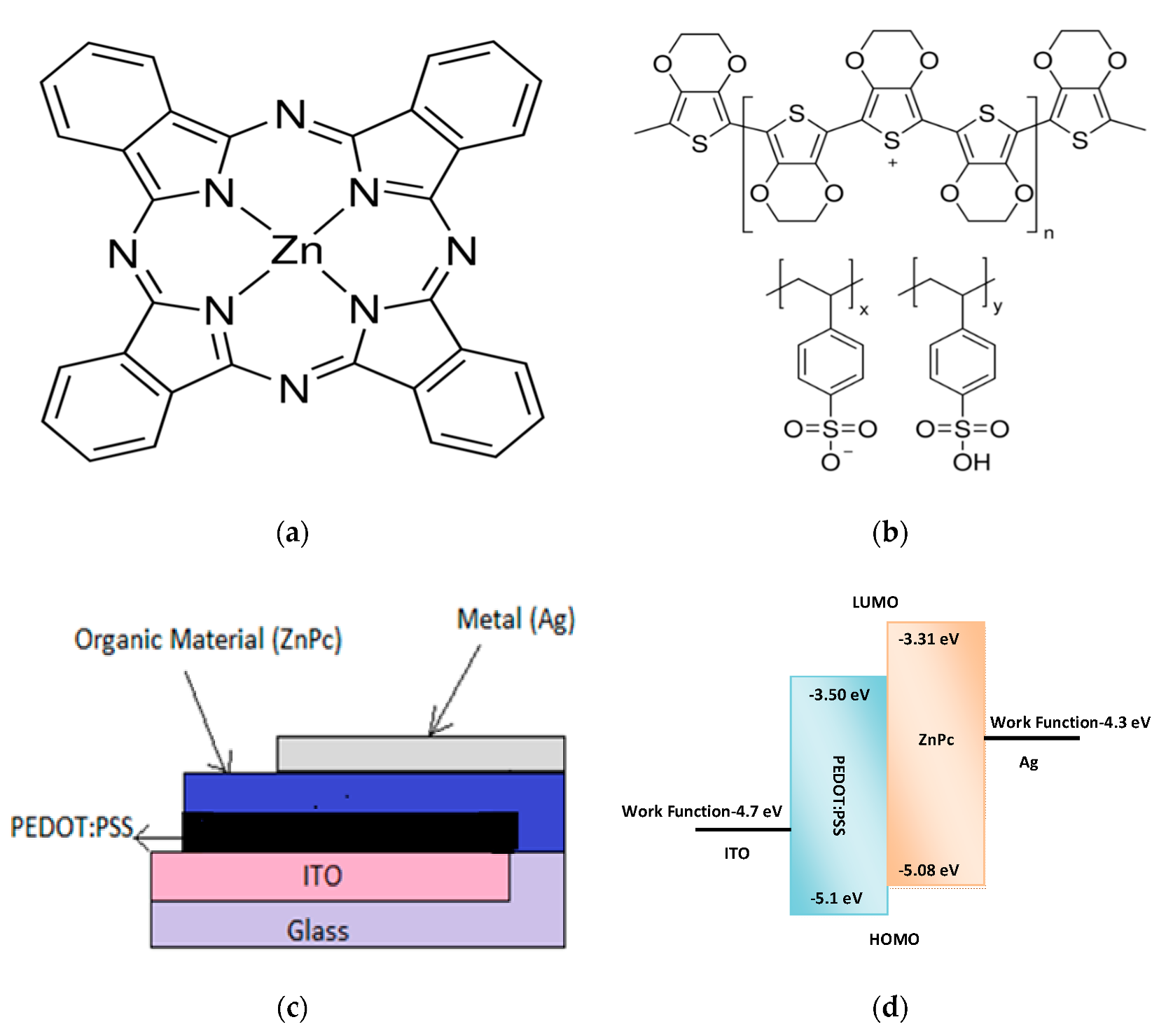
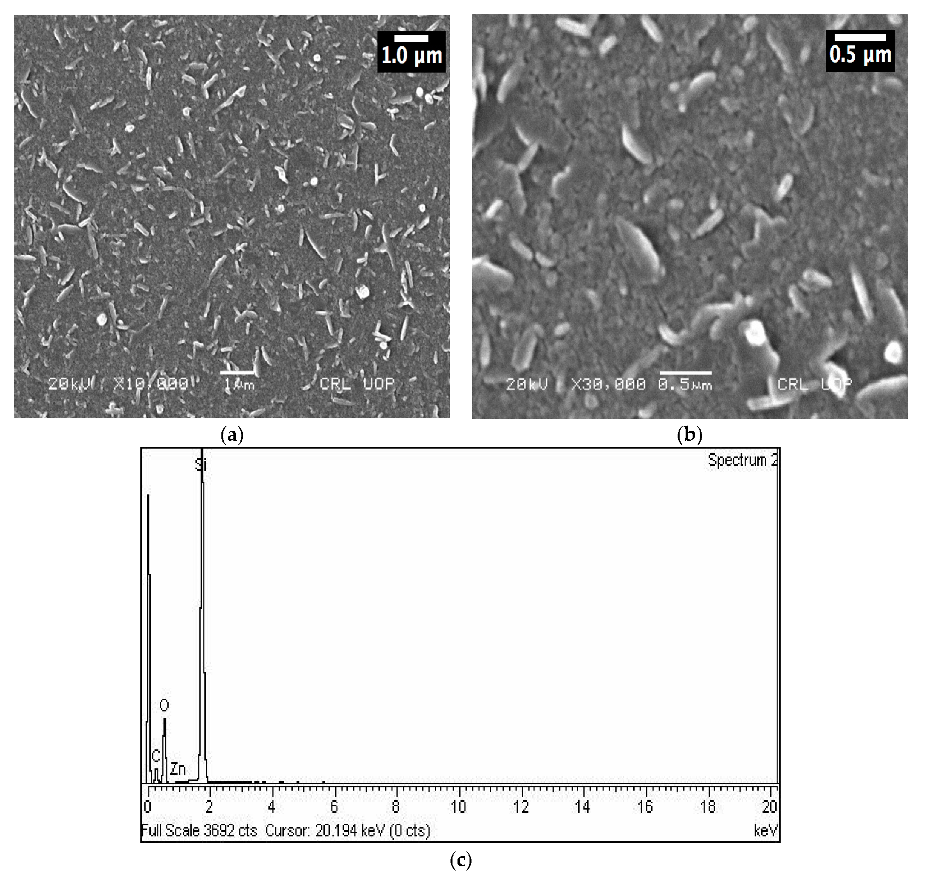
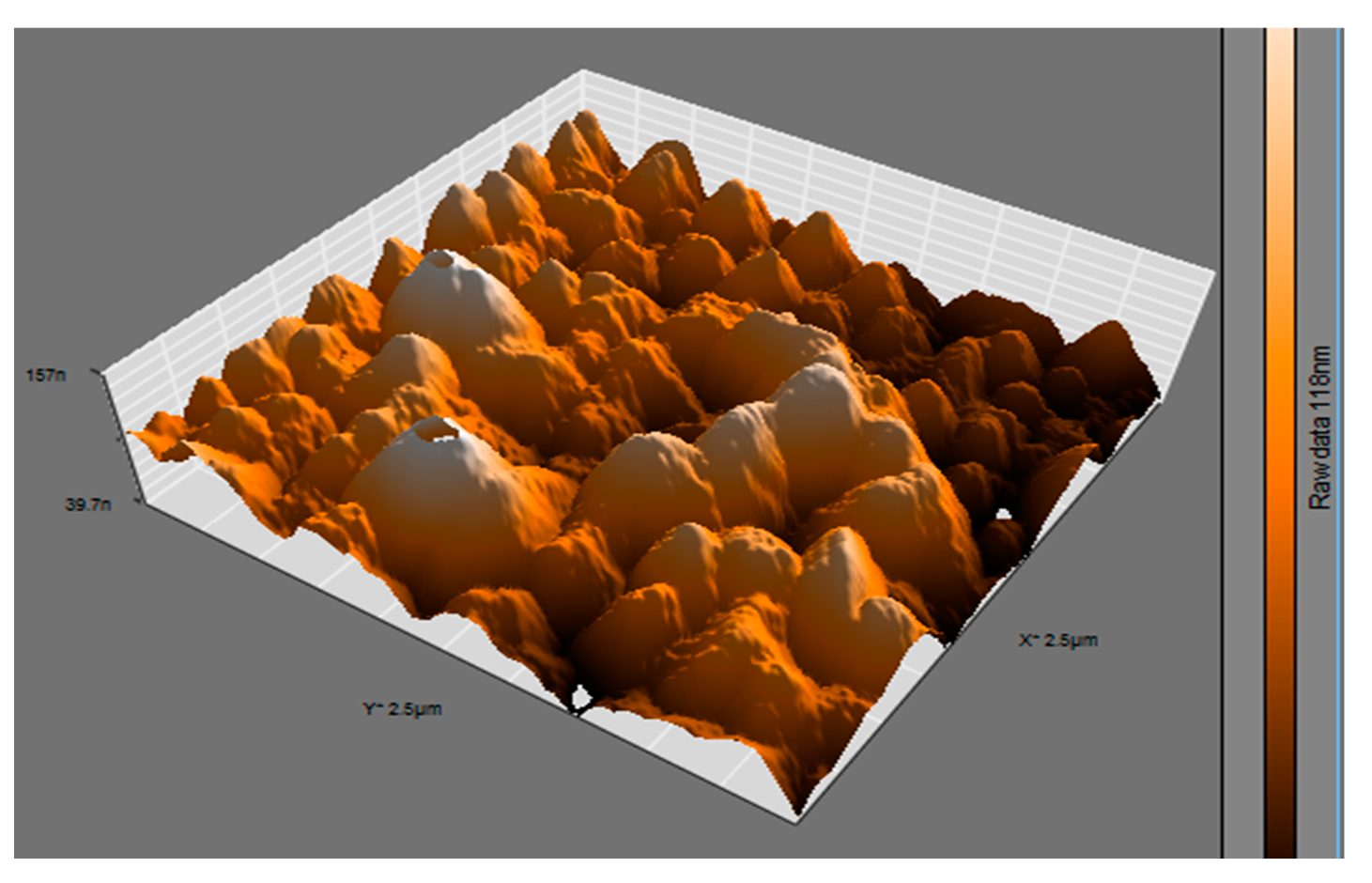
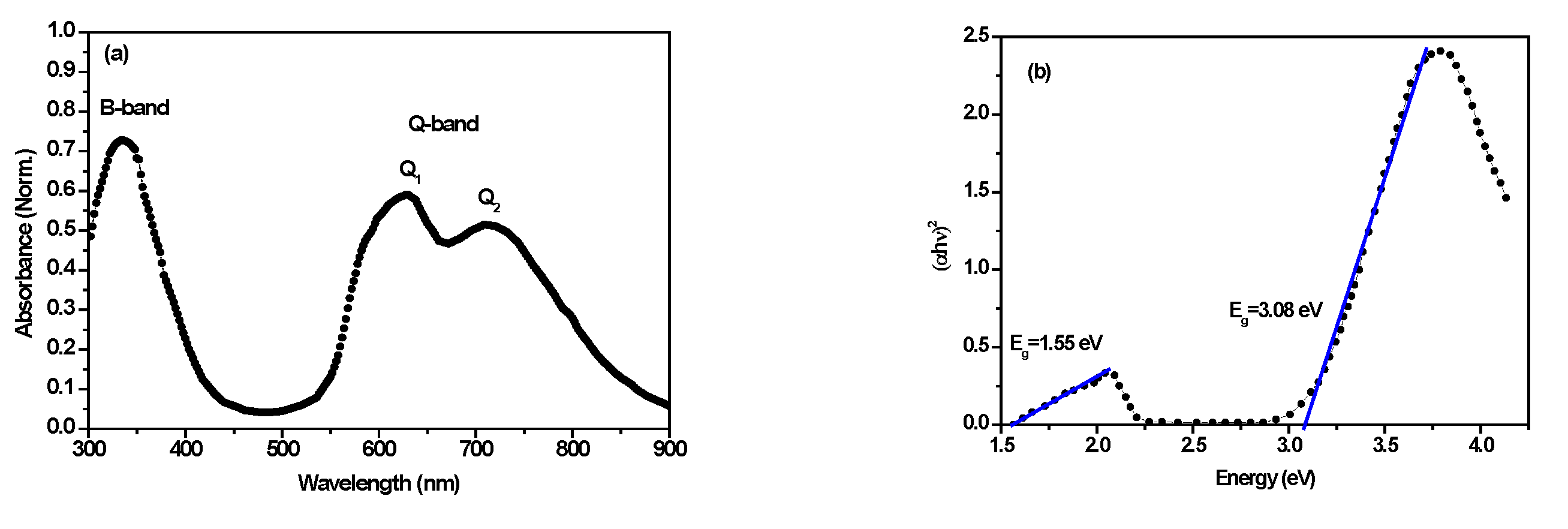
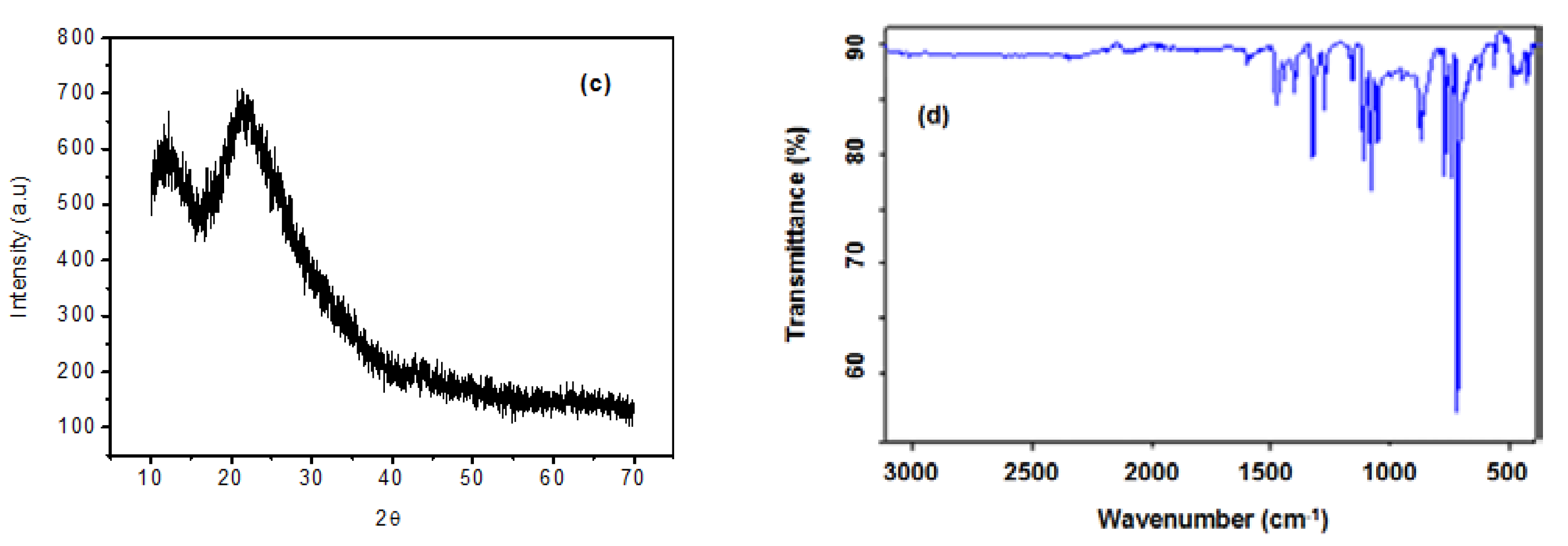
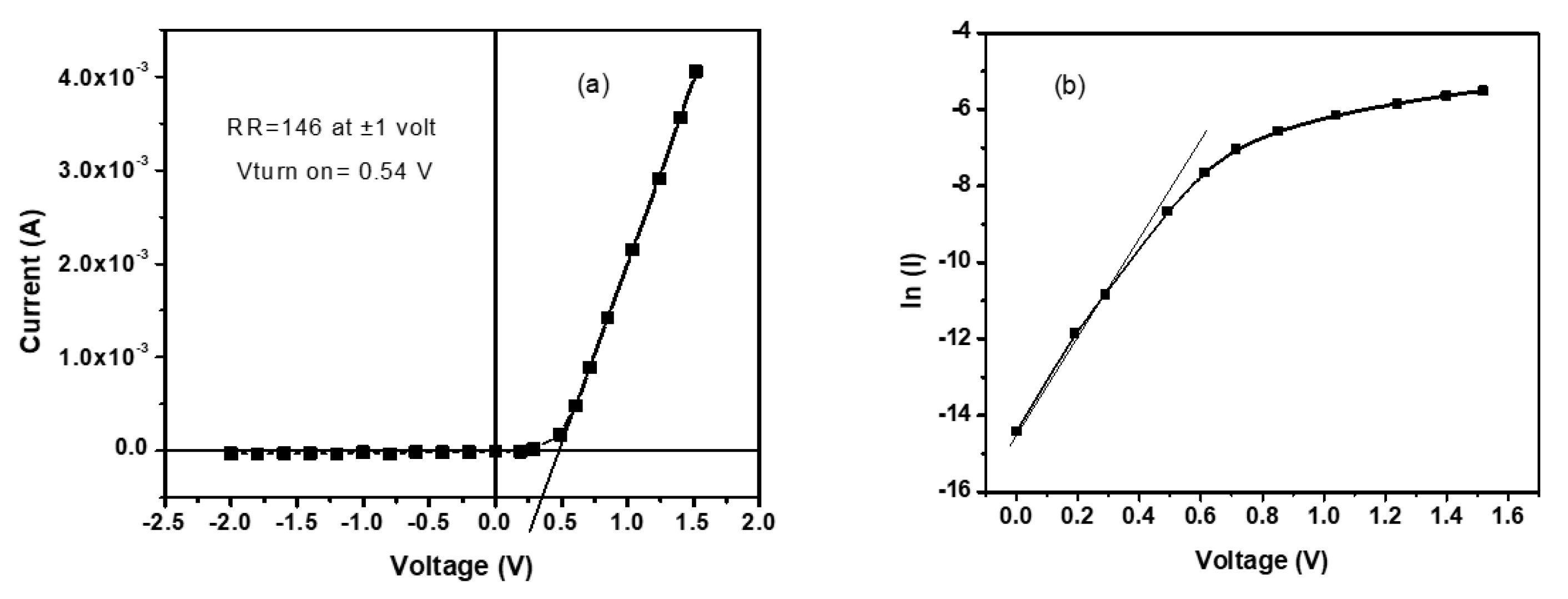
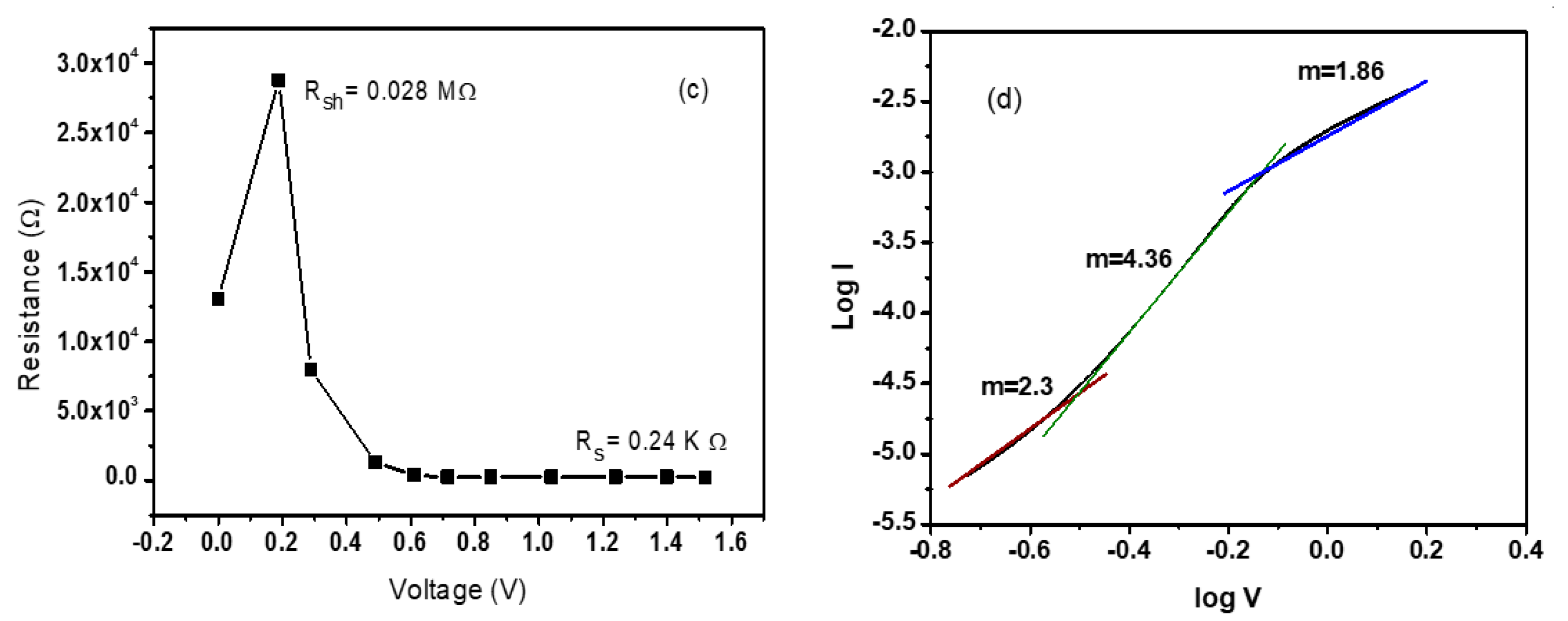
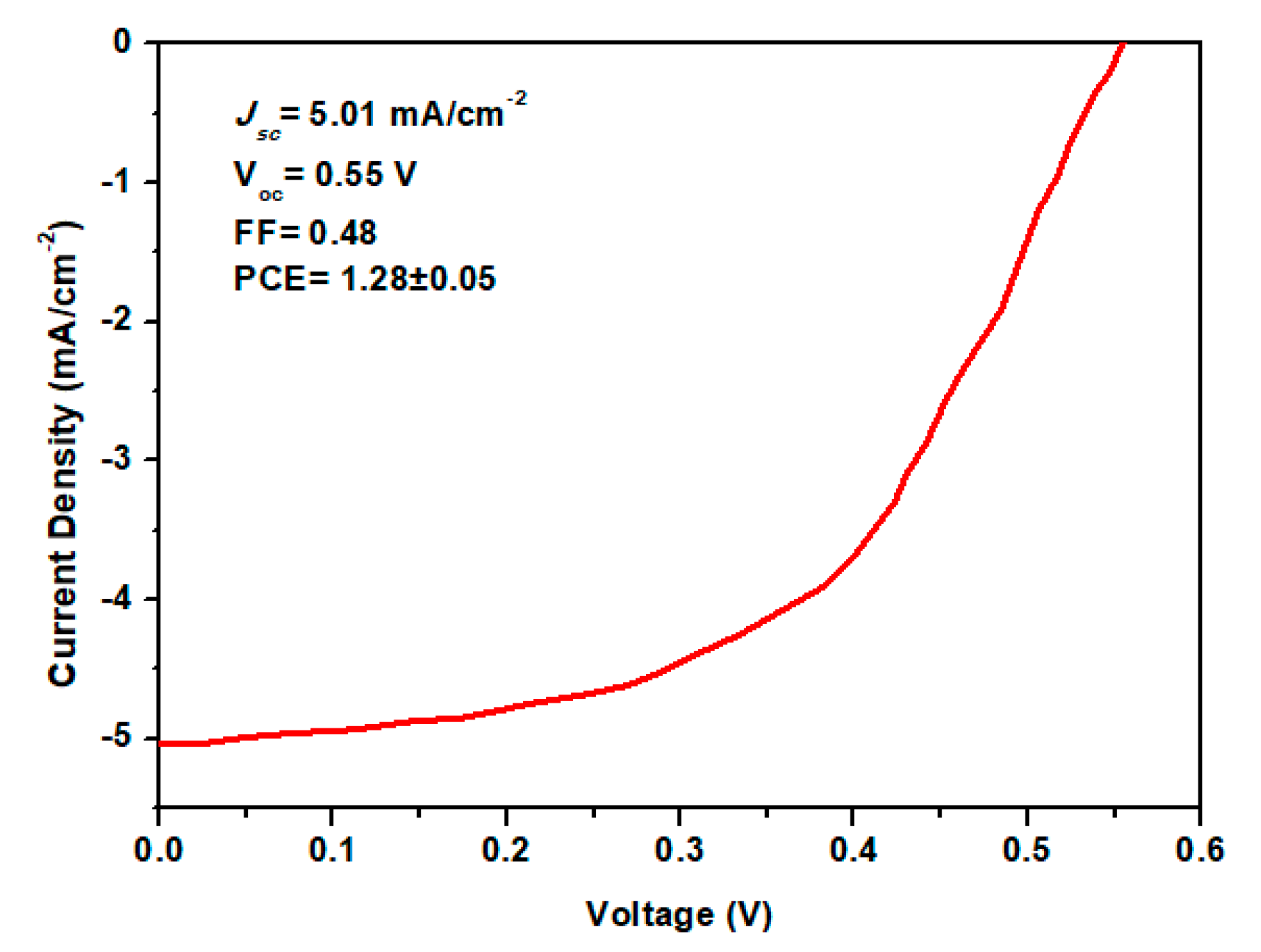
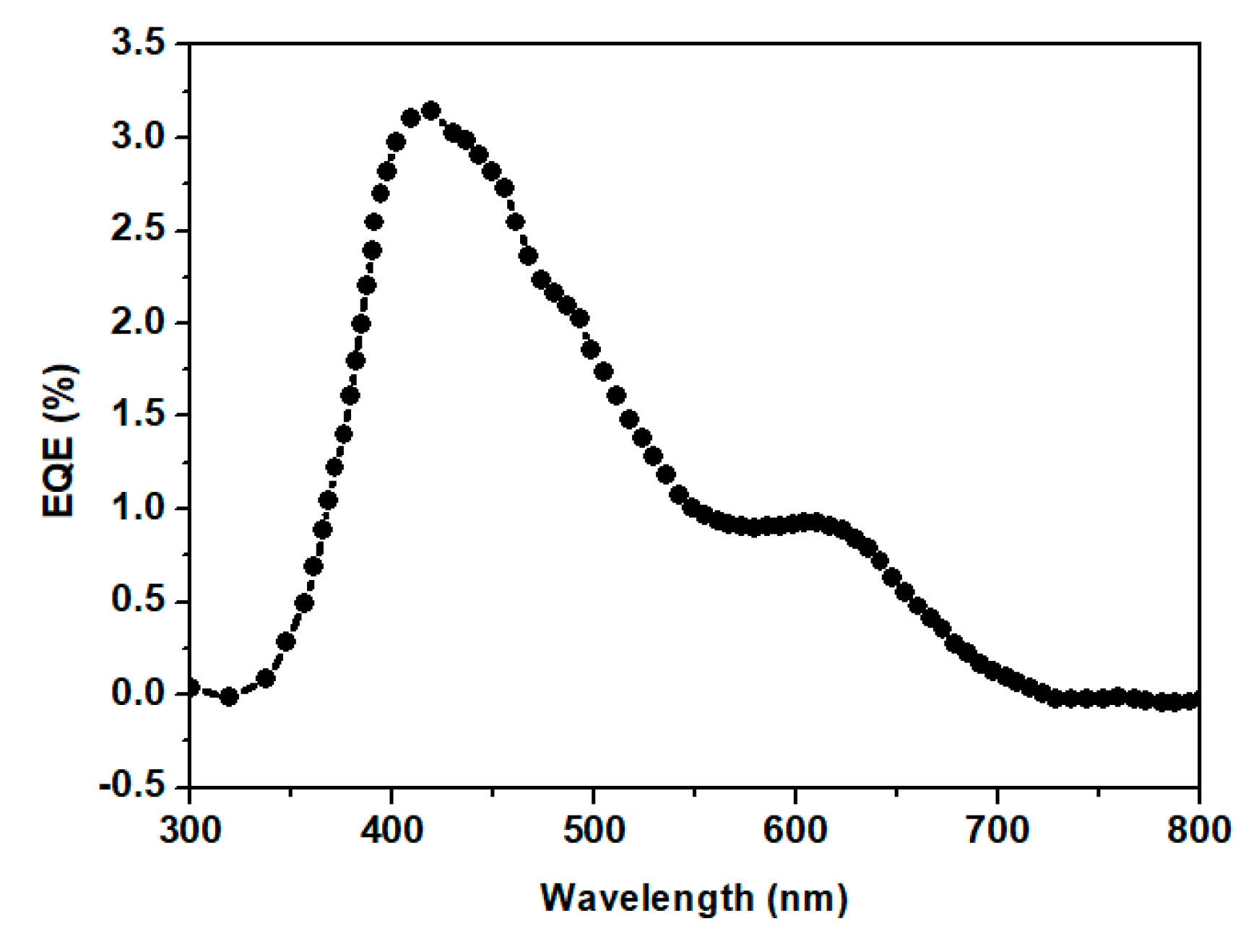
| Element | C K | O K | Si K | Zn K | Total |
|---|---|---|---|---|---|
| Weight % | 24.77 | 39.21 | 35.73 | 0.29 | 100 |
| Atomic % | 35.63 | 42.33 | 21.97 | 0.08 |
| Peaks (cm−1) | Assignment |
|---|---|
| 721 | Out-of-Plane C-H Bend |
| 751 | In-Plane C-H Bend |
| 886 | Out-of-Plane C-H Bend |
| 1057 | In-Plane C-H Bend |
| 1084 | In-Plane C-H Bend |
| 1116 | In-Plane C-H Bend |
| 1165 | In-Plane C-H Bend |
| 1285 | In-Plane C-H Bend |
| 1329 | In-Plane Pyrrole Stretch |
| 1408 | Isoindole Stretch |
| 1484 | C-C Benzene Stretch |
| 1522 | C-C Benzene Stretch |
| 1606 | C-C Benzene Stretch |
| 1722 | C-H Stretch |
| Phthalocyanine Film | RR | VOC (V) | JSC (mA/cm2) | (FF) | PCE (%) | Reference |
|---|---|---|---|---|---|---|
| VOPcPhO | 3.12 | 0.621 | 5.26 × 10−3 | 0.33 | 1.08 × 10−3 | [3] |
| CuPc | 0.7 | 9 × 10−3 | 0.31 | 1.93 × 10−3 | [31] | |
| ZnPc | 146 | 0.55 | 5.01 | 0.48 | 1.28 ± 0.05 | Present work |
© 2020 by the authors. Licensee MDPI, Basel, Switzerland. This article is an open access article distributed under the terms and conditions of the Creative Commons Attribution (CC BY) license (http://creativecommons.org/licenses/by/4.0/).
Share and Cite
Islam, Z.U.; Tahir, M.; Syed, W.A.; Aziz, F.; Wahab, F.; Said, S.M.; R. Sarker, M.; Md Ali, S.H.; Sabri, M.F.M. Fabrication and Photovoltaic Properties of Organic Solar Cell Based on Zinc Phthalocyanine. Energies 2020, 13, 962. https://doi.org/10.3390/en13040962
Islam ZU, Tahir M, Syed WA, Aziz F, Wahab F, Said SM, R. Sarker M, Md Ali SH, Sabri MFM. Fabrication and Photovoltaic Properties of Organic Solar Cell Based on Zinc Phthalocyanine. Energies. 2020; 13(4):962. https://doi.org/10.3390/en13040962
Chicago/Turabian StyleIslam, Zahoor Ul, Muhammad Tahir, Waqar Adil Syed, Fakhra Aziz, Fazal Wahab, Suhana Mohd Said, Mahidur R. Sarker, Sawal Hamid Md Ali, and Mohd Faizul Mohd Sabri. 2020. "Fabrication and Photovoltaic Properties of Organic Solar Cell Based on Zinc Phthalocyanine" Energies 13, no. 4: 962. https://doi.org/10.3390/en13040962
APA StyleIslam, Z. U., Tahir, M., Syed, W. A., Aziz, F., Wahab, F., Said, S. M., R. Sarker, M., Md Ali, S. H., & Sabri, M. F. M. (2020). Fabrication and Photovoltaic Properties of Organic Solar Cell Based on Zinc Phthalocyanine. Energies, 13(4), 962. https://doi.org/10.3390/en13040962





